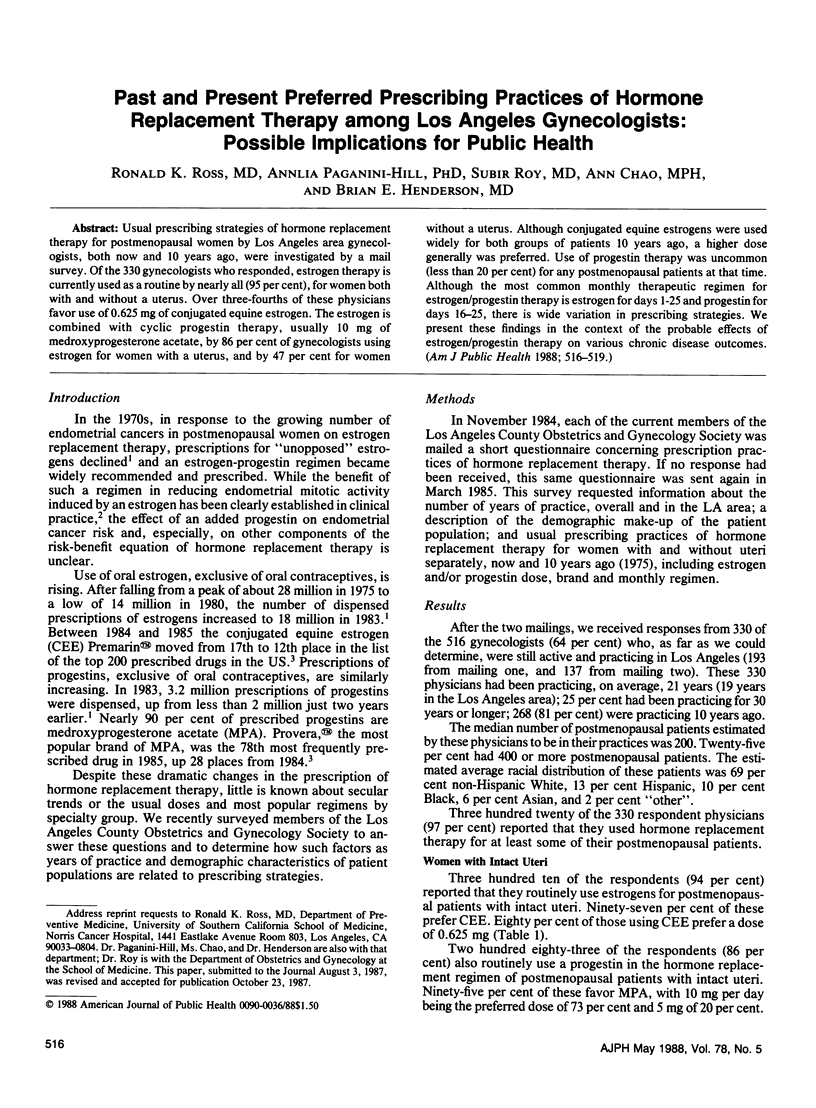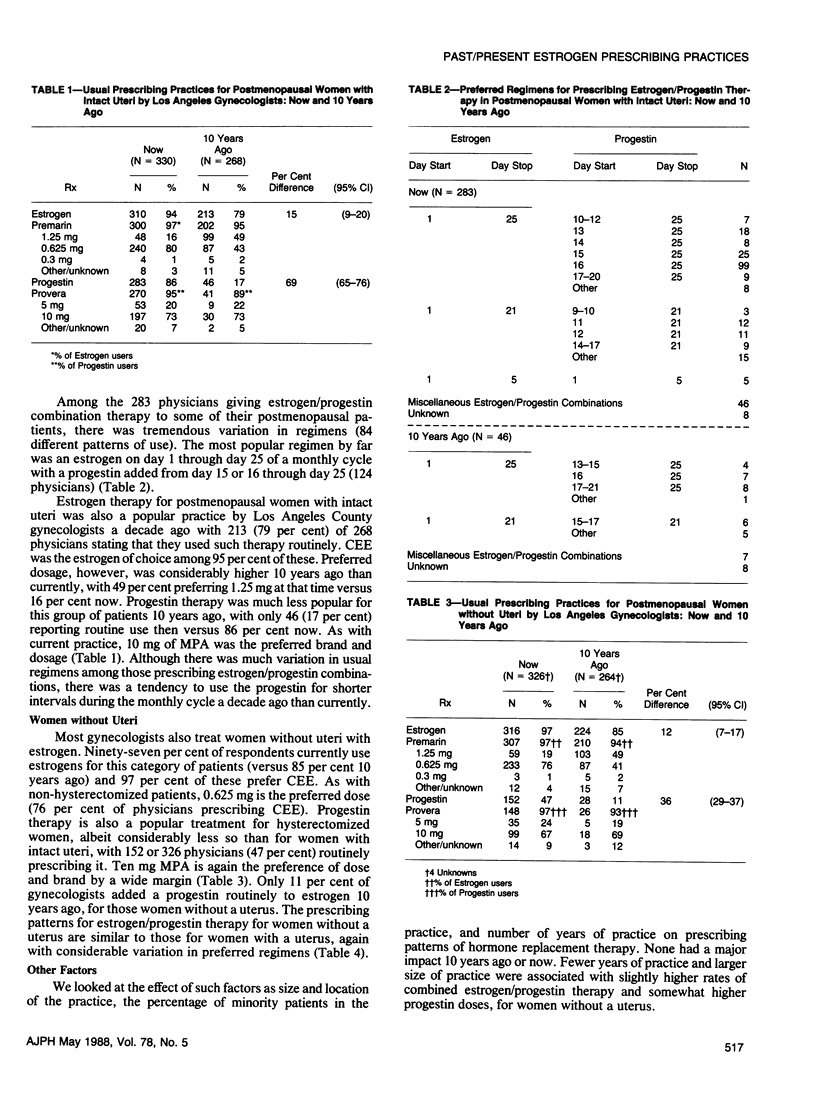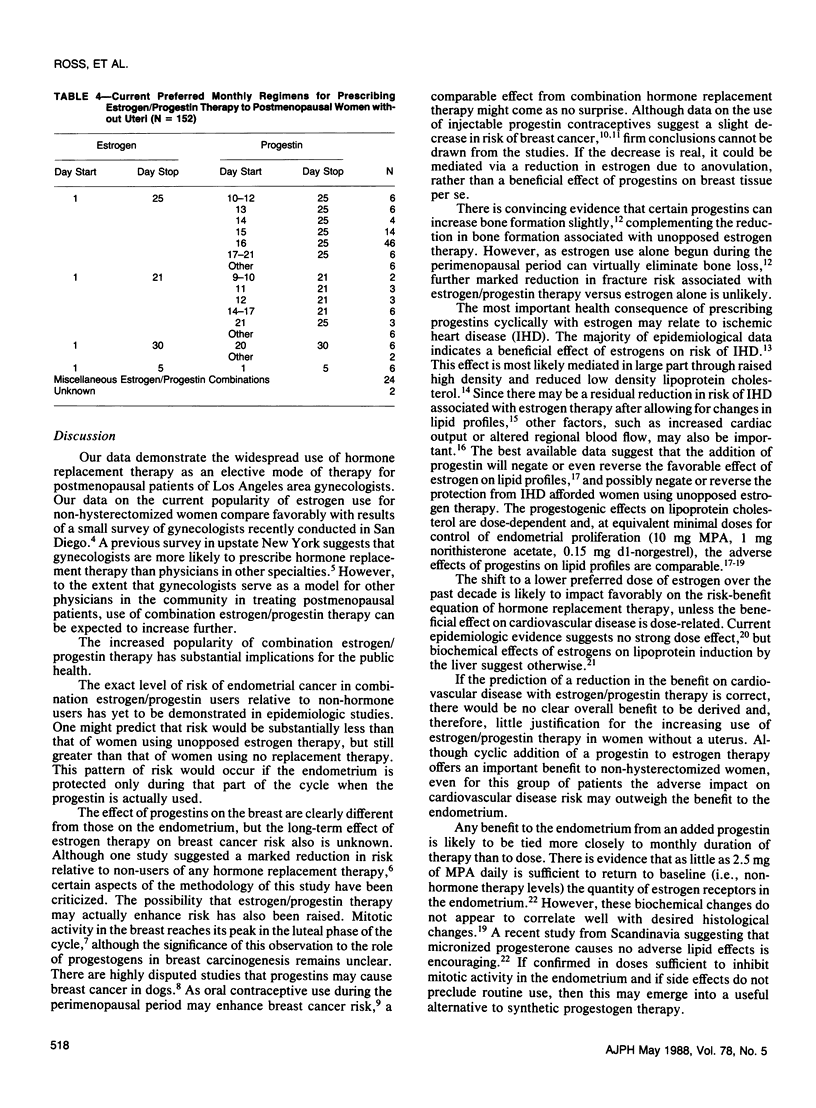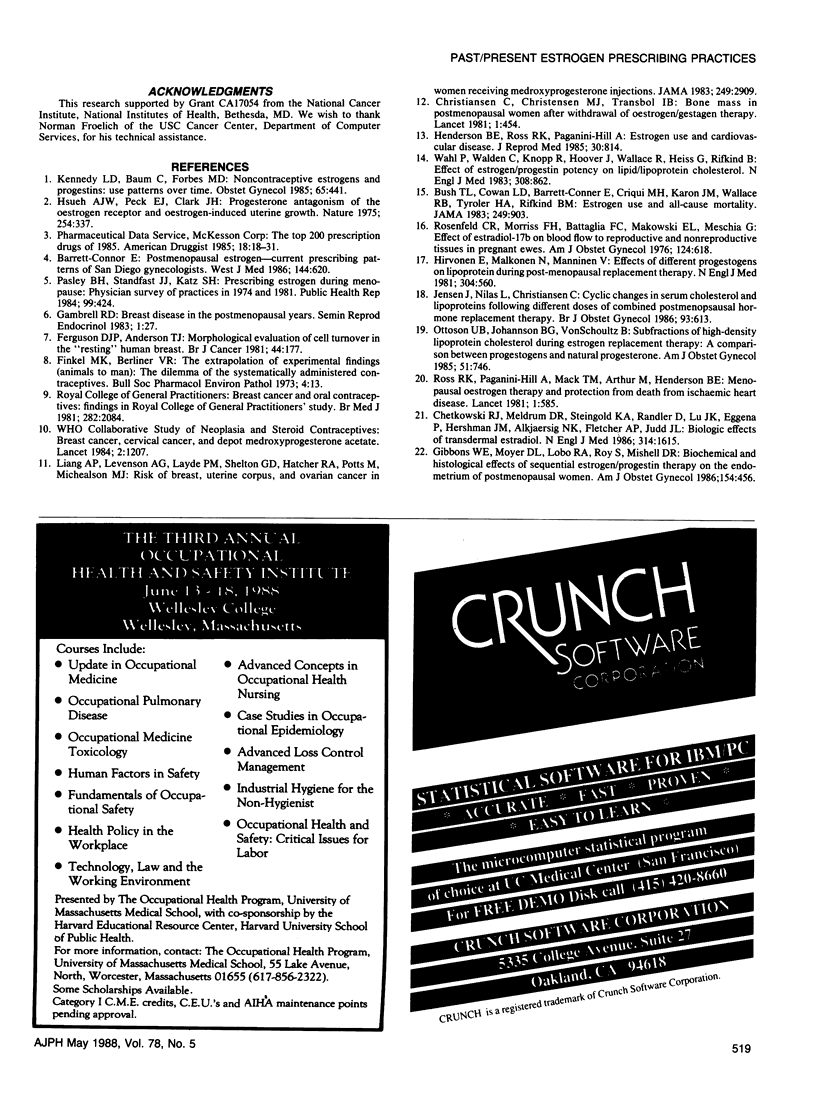Abstract
Usual prescribing strategies of hormone replacement therapy for postmenopausal women by Los Angeles area gynecologists, both now and 10 years ago, were investigated by a mail survey. Of the 330 gynecologists who responded, estrogen therapy is currently used as a routine by nearly all (95 per cent), for women both with and without a uterus. Over three-fourths of these physicians favor use of 0.625 mg of conjugated equine estrogen. The estrogen is combined with cyclic progestin therapy, usually 10 mg of medroxyprogesterone acetate, by 86 per cent of gynecologists using estrogen for women with a uterus, and by 47 per cent for women without a uterus. Although conjugated equine estrogens were used widely for both groups of patients 10 years ago, a higher dose generally was preferred. Use of progestin therapy was uncommon (less than 20 per cent) for any postmenopausal patients at that time. Although the most common monthly therapeutic regimen for estrogen/progestin therapy is estrogen for days 1-25 and progestin for days 16-25, there is wide variation in prescribing strategies. We present these findings in the context of the probable effects of estrogen/progestin therapy on various chronic disease outcomes.
Full text
PDF



Selected References
These references are in PubMed. This may not be the complete list of references from this article.
- Barrett-Connor E. Postmenopausal estrogens--current prescribing patterns of San Diego gynecologists. West J Med. 1986 May;144(5):620–621. [PMC free article] [PubMed] [Google Scholar]
- Bush T. L., Cowan L. D., Barrett-Connor E., Criqui M. H., Karon J. M., Wallace R. B., Tyroler H. A., Rifkind B. M. Estrogen use and all-cause mortality. Preliminary results from the Lipid Research Clinics Program Follow-Up Study. JAMA. 1983 Feb 18;249(7):903–906. doi: 10.1001/jama.249.7.903. [DOI] [PubMed] [Google Scholar]
- Chetkowski R. J., Meldrum D. R., Steingold K. A., Randle D., Lu J. K., Eggena P., Hershman J. M., Alkjaersig N. K., Fletcher A. P., Judd H. L. Biologic effects of transdermal estradiol. N Engl J Med. 1986 Jun 19;314(25):1615–1620. doi: 10.1056/NEJM198606193142505. [DOI] [PubMed] [Google Scholar]
- Dyckner T., Wester P. O. Effects of magnesium infusions in diuretic induced hyponatraemia. Lancet. 1981 Mar 14;1(8220 Pt 1):585–586. doi: 10.1016/s0140-6736(81)92034-1. [DOI] [PubMed] [Google Scholar]
- Ferguson D. J., Anderson T. J. Morphological evaluation of cell turnover in relation to the menstrual cycle in the "resting" human breast. Br J Cancer. 1981 Aug;44(2):177–181. doi: 10.1038/bjc.1981.168. [DOI] [PMC free article] [PubMed] [Google Scholar]
- Gibbons W. E., Moyer D. L., Lobo R. A., Roy S., Mishell D. R., Jr Biochemical and histologic effects of sequential estrogen/progestin therapy on the endometrium of postmenopausal women. Am J Obstet Gynecol. 1986 Feb;154(2):456–461. doi: 10.1016/0002-9378(86)90690-3. [DOI] [PubMed] [Google Scholar]
- Henderson B. E., Ross R. K., Paganini-Hill A. Estrogen use and cardiovascular disease. J Reprod Med. 1985 Oct;30(10 Suppl):814–820. [PubMed] [Google Scholar]
- Hirvonen E., Mälkönen M., Manninen V. Effects of different progestogens on lipoproteins during postmenopausal replacement therapy. N Engl J Med. 1981 Mar 5;304(10):560–563. doi: 10.1056/NEJM198103053041002. [DOI] [PubMed] [Google Scholar]
- Hsueh A. J., Peck E. J., Jr, clark J. H. Progesterone antagonism of the oestrogen receptor and oestrogen-induced uterine growth. Nature. 1975 Mar 27;254(5498):337–339. doi: 10.1038/254337a0. [DOI] [PubMed] [Google Scholar]
- Jensen J., Nilas L., Christiansen C. Cyclic changes in serum cholesterol and lipoproteins following different doses of combined postmenopausal hormone replacement therapy. Br J Obstet Gynaecol. 1986 Jun;93(6):613–618. doi: 10.1111/j.1471-0528.1986.tb08035.x. [DOI] [PubMed] [Google Scholar]
- Kennedy D. L., Baum C., Forbes M. B. Noncontraceptive estrogens and progestins: use patterns over time. Obstet Gynecol. 1985 Mar;65(3):441–446. [PubMed] [Google Scholar]
- Liang A. P., Levenson A. G., Layde P. M., Shelton J. D., Hatcher R. A., Potts M., Michelson M. J. Risk of breast, uterine corpus, and ovarian cancer in women receiving medroxyprogesterone injections. JAMA. 1983 Jun 3;249(21):2909–2912. [PubMed] [Google Scholar]
- Ottosson U. B., Johansson B. G., von Schoultz B. Subfractions of high-density lipoprotein cholesterol during estrogen replacement therapy: a comparison between progestogens and natural progesterone. Am J Obstet Gynecol. 1985 Mar 15;151(6):746–750. doi: 10.1016/0002-9378(85)90509-5. [DOI] [PubMed] [Google Scholar]
- Pasley B. H., Standfast S. J., Katz S. H. Prescribing estrogen during menopause: physician survey of practices in 1974 and 1981. Public Health Rep. 1984 Jul-Aug;99(4):424–429. [PMC free article] [PubMed] [Google Scholar]
- Rosenfeld C. R., Morriss F. H., Jr, Battaglia F. C., Makowski E. L., Meschia G. Effect of estradiol-17beta on blood flow to reproductive and nonreproductive tissues in pregnant ewes. Am J Obstet Gynecol. 1976 Mar 15;124(6):618–629. doi: 10.1016/0002-9378(76)90064-8. [DOI] [PubMed] [Google Scholar]
- Wahl P., Walden C., Knopp R., Hoover J., Wallace R., Heiss G., Rifkind B. Effect of estrogen/progestin potency on lipid/lipoprotein cholesterol. N Engl J Med. 1983 Apr 14;308(15):862–867. doi: 10.1056/NEJM198304143081502. [DOI] [PubMed] [Google Scholar]


